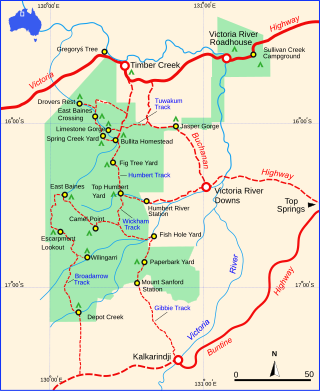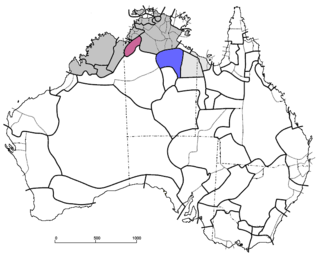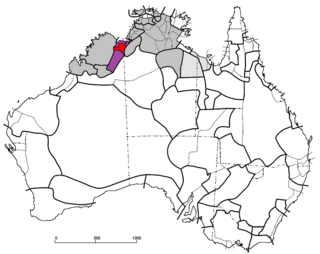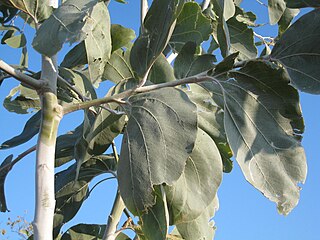Related Research Articles

Judbarra National Park, formerly Gregory National Park and Judbarra / Gregory National Park, is a national park in the Northern Territory of Australia, 359 km (223 mi) south of Darwin.
Gija, also spelt Gidja and Kija, alternatively known as the Lungga, refers to Aboriginal Australians from the East Kimberley area of Western Australia, about 200 km south of Kununurra. In the late 19th century pastoralists were fiercely resisted by Gija people, many of whom now live around localities such as Halls Creek and Warmun.
Ngan'gi, formerly known as Ngan'gityemerri, and also known as Ngan'gikurunggurr, Moil/Moyle, Tyemeri/Tyemerri, Marityemeri, and Nordaniman, is an Australian Aboriginal language spoken in the Daly River region of Australiaʼs Northern Territory. There are three mutually intelligible dialects, with the two sister dialects known as Ngen'giwumirri and Ngan'gimerri.

The Mirndi or Mindi languages are an Australian language family spoken in the Northern Territory of Australia. The family consists of two sub-groups and an isolate branch: the Yirram languages, and the Ngurlun languages and Jingulu language some 200 km farther to the southeast, separated by the Ngumpin languages. The primary difference between the two sub-groups is that while the Yirram languages are all prefixing like other non-Pama–Nyungan languages, the Ngurlun languages are all suffixing like most Pama–Nyungan languages.

The Yirram or Jaminjungan languages, also known as Western Mirndi, are a branch of the Mirndi languages spoken around the Victoria River in the Northern Territory of Australia. The name of these languages is derived from the dual clitic which is "yirram" in each of the languages.

Miriwoong, also written Miriuwung and Miriwung, is an Aboriginal Australian language which today has fewer than 20 fluent speakers, most of whom live in or near Kununurra in Western Australia. All of the fluent speakers are elderly and the Miriwoong language is considered to be critically endangered. However, younger generations tend to be familiar with a lot of Miriwoong vocabulary which they use when speaking Kimberley Kriol or Aboriginal English, and there is active language revitalization.
Murrinh-patha, called Garama by the Jaminjung, is an Australian Aboriginal language spoken by over 2,000 people, most of whom live in Wadeye in the Northern Territory, where it is the dominant language of the community. It is spoken by the Murrinh-Patha people, as well as several other peoples whose languages are extinct or nearly so, including the Mati Ke and Marri-Djabin. It is believed to be the most widely spoken Australian Aboriginal language not belonging to the Pama-Nyungan language family.
Nungali, or Yilngali, is an Australian language which is believed to be extinct. It was spoken in the Northern Territory of Australia, around the upper Daly River. Its closest relative is the Jaminjung language.

The Bradshaw Field Training Area (BFTA) is a large army training area located 600 km (370 mi) south of Darwin in the Northern Territory of Australia. It is used for training by the Australian Army, and as an Australia-U.S. combined training centre with the U.S. Marines stationed at Darwin.
Gurindji is a Pama–Nyungan language spoken by the Gurindji and Ngarinyman people in the Northern Territory, Australia. The language of the Gurindji is highly endangered, with about 592 speakers remaining and only 175 of those speakers fully understanding the language. There are in addition about 60 speakers of Ngarinyman dialect. Gurindji Kriol is a mixed language that derives from the Gurindji language.
Nungali, or Yilngali, is an Australian language which is believed to be extinct. It was spoken in the Northern Territory of Australia, around the upper Daly River. Its closest relative is the Jaminjung language.
Limilngan, also known as Limil and Manidja, is an extinct Aboriginal Australian language of the Top End of Australia.
Alawa (Galawa) is a moribund Indigenous Australian language spoken by the Alawa people of the Northern Territory. In 1991, there were reportedly 18 remaining speakers and 4 semi-speakers.

Lysiphyllum cunninghamii is a species of plant in the family Fabaceae. It is native to northern Australia where it occurs from Western Australia through the Northern Territory to Queensland.

Ficus coronulata, commonly known as the peach-leaf fig, and in the Northern Territory as river fig and crown fig, is one of several fig species commonly known as sandpaper figs. It is native to Western Australia and the Northern Territory.

Acacia dunnii, commonly known as elephant ear wattle or Dunn's wattle, is a shrub or tree of the genus Acacia and the subgenus Plurinerves.
The Nungali, otherwise known as the Ilngali, are an Indigenous Australian people of the Northern Territory.
The Jamindjung, also spelt Djamindjung, are an indigenous Australian people of the Northern Territory.
The Ngaliwurru are an indigenous Australian people of the Northern Territory.
Glenn Mitchell Wightman is an ethnobotanist working for the Department of Environment Parks and Water Security, in Palmerston. He works closely with various aboriginal language groups to document plant and animal names and their usage in the culture. In doing so, he has been helping to preserve some 48 Aboriginal languages in collaboration with some 252 Indigenous co-authors. He has also done biocultural work in Indonesia.
References
Notes
- 1 2 Jaminjung at Ethnologue (25th ed., 2022)

- ↑ N18 Jaminjung at the Australian Indigenous Languages Database, Australian Institute of Aboriginal and Torres Strait Islander Studies (see the info box for additional links)
- ↑ Endangered Languages Project data for Ngaliwurru.
- ↑ Schultze-Berndt 2000 , pp. 13–14
- ↑ Janet E. Bolt; William G. Hoddinott; Frances Kofod (1971), An elementary grammar of the Ngaliwuru language of the Northern Territory, Wikidata Q131317614
- ↑ Judy Merchant Jones; Dolly Bardbarriya; Eileen Raymond; et al. (2011). "Jaminjung, Ngaliwurru and Nungali plants and animals: Aboriginal flora and fauna knowledge from the Bradshaw and Judbarra/Gregory National Park area, north Australia". Northern Territory Botanical Bulletin. 38. Diwurruwurru-Jaru Aboriginal Corporation. ISBN 978-1-921519-49-9. Wikidata Q131319408.
- 1 2 3 Schultze-Berndt 2000 , p. 41
General
- Schultze-Berndt, Eva F. (2000). Simple and Complex Verbs in Jaminjung - A Study of event categorisation in an Australian language (Thesis). Radboud University. hdl:2066/147040. ISBN 90-76203-09-1.
- Jones, Judy Marchant; Bardbarriya, Dolly; Raymond, Eileen; Roberts, Doris; McDonald, Duncan; McDonald, Dinah; McDonald, Margaret; Simard, Candide; Moerkerken, Colleen; Wightman, Glenn (2011). Jaminjung, Ngaliwurru and Nungali Plants and Animals: Aboriginal knowledge of flora and fauna from the Bradshaw and Judbarra/Gregory National Park area, north Australia. Northern Territory Botanical Bulletin. Vol. 38. Palmerston, N. T.: Department of Natural Resources, Environment, the Arts and Sport. ISBN 9781921519499.